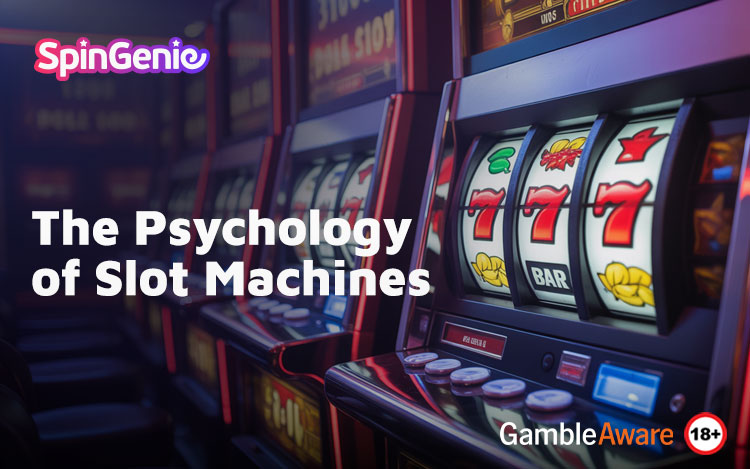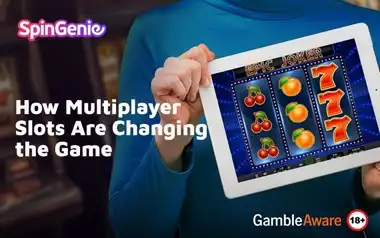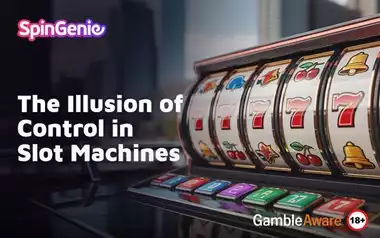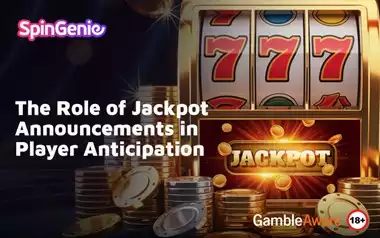Almost everything in life comes down to some manner of psychology; it’s why businesses often spend more on marketing than on the product itself. Similarly, there’s some simple yet powerful psychology behind gambling which is applied to all casino games, whether online, live, or real-world, and slot machines are no exception.
In this article, we will discover the 5 psychological elements that underpin the very nature of online slots in the UK and how being aware of these factors and the slot player behaviours that drive them can help keep your gameplay responsible.
1. Gambler’s Fallacy and The Illusion of Control
People do not like to feel as though they lack control; it feels demeaning and unsettling - two factors which certainly do not correlate with a positive and memorable gameplay experience that players want to return to.
While of course there are plenty of factors that the players can control, such as when they play, what they play, and how much they spend, as well as basic in-game options such as bet configuration and paylines (where unfixed), 100% of the gameplay is down to random chance. Over the years, there have been many ways in which slots have encouraged player autonomy; Wazdan, for example, are well-known for the multi-option free spins bonus round, and older slots include optional gamble features, but overall, player control is incredibly limited.
If there’s one thing the brain is great at, it is adjusting our reality to avoid uncertainty and maintain an equilibrium. When faced with games of chance, such as slots, the brain wants to feel in control and therefore creates an illusion of such. This results in a phenomenon known as the ‘Gambler’s Fallacy’.
Gambler's fallacy is the incorrect notion that if an event has happened more often than normal in the past, it will happen less often in the future, or vice versa. This cognitive bias believes that previous results affect future independent occurrences, which, in games of complete random chance, such as simple coin flips, dice rolls, or spins of a slot machine.
The brain loves to find patterns in things; it helps the world to make more sense, and these existing connections and underlying patterns are less mentally taxing. This results in the gambler's fallacy as the brain applies a pattern to a completely random process. Which is why players end up with the belief that if a coin lands on heads several times, it is "due" to land on tails. The coin has no memory, so each flip has a 50/50 chance of landing on either side, and the player has no control or influence over this.
A similar example of the illusion of control has been seen throughout history in sports, games, and general life; in fact, you have probably used this illusion before. Do you have a lucky number, a lucky pair of socks, or a favoured object that you feel works best? If so, then you’re unwittingly trying to insert predictability, patterns, and control into the activity you're doing. Deep down, we all know wearing the same shirt that you won a large slot payout on previously has no practical correlation, but still, we continue to extol the virtues of our ‘lucky charm’.
2. Sensory Stimulation and Environmental Control
From the flashing lights, bright colours, and cacophony of sounds experienced at real-world casinos, to the immersive soundtracks, themes, and animations of online slots, complete with a bombastic fanfare upon winning outcomes, these games are designed to keep us in a heightened state of stimulation.
Depending on the stimuli, the brain releases dopamine, oxytocin, endorphins, and serotonin. These neurotransmitters and hormones affect motivation, well-being, and social engagement. When we are stimulated by a gambling game, such as slots, dopamine is the chief chemical at play.
Dopamine comes from the brain's reward system and is released after favourable sensory experiences, such as eating nice food or taking part in an enjoyable activity and is a key motivator and contributor to the 'just one more spin' mentality that we'll explore later on.
Stress and tension (such as through anticipation), as well as enjoyable and comforting activities (such as clicking spin over and over), can release endorphins and boost feelings of well-being. Serotonin is the neurotransmitter largely behind the positive and satisfied feeling at the end of an activity, such as logging off after a fun slot experience, and it is this and dopamine which work together to develop the urge to play again, whether as part of a healthy hobby or on the darker side, as a compulsion.
The chemicals released and their effects depend on sensory input, individual differences, and context. For instance, intense or aversive stimuli can affect a person differently than pleasant ones. It has been well-known for years that physical casino locations utilise knowledge of sensory stimulation to develop a controlled environment conducive to extended play times and recidivism. The perfect example of this is the lack of clocks in Las Vegas casinos. In an online setting, this is largely achieved through immersive theming and gamification (more on this later).
3. Heightened Arousal and The Role of Near Misses
When we speak in science terms, the level of stimulation and engagement a participant exhibits is known as ‘arousal’. Note that while this can refer to sexual matters, more often than not it refers to bodily signs of excitement such as heart rate, pupil dilation, breathing patterns and so on.
Slot machines are all about stimulation and arousal. This hyper arousal is something which ‘near misses’, whether perceived or actual, feed into. In a controlled environment (as we explored in the previous point), near misses can bring just as potent a dopamine response as a win can. As we learned, dopamine is a vital chemical for motivation, and thus, when hit with a jolt of dopamine, players can feel a rush of motivation to keep on playing, leading to the ‘just one more spin’ mentality.
4. The ‘Just One More Spin’ Mentality
Slot machines have been refined over the years to use the motivation from a dopamine spike to keep players spinning (and spending) for longer. The players refer to this as the ‘just one more spin’ mentality, but for developers it is known as ‘reinforcement scheduling.
In psychology, reinforcement schedules determine reward timing. Slot games use a variable ratio reinforcement schedule, kept fair by pseudo-RNG (PRNG) technology to keep outcomes random. For example, a low volatility slot engages players with the satisfaction of small but consistent wins, whilst high volatility games ‘hold out’ on players, feeding into the near miss phenomenon and tempting players with ‘just one more spin’.
This is why the volatility of slot games are carefully considered by developers, and this rating helps shape the theme and design of the game. For example, high volatility is suited to an epic jackpot slot inspired by the Greek Gods, while it would be out of place in a laid-back beach vacation game. This can lead to a slot never finding its audience as those that like the theme don’t enjoy the gameplay experience and vice versa.
5. Gamification and Cognitive Dissonance
You’ve probably heard the phrase ‘to bury one’s head in the sand’, and this exemplifies a psychological phenomenon known as ‘Cognitive Dissonance’. First coined early in the 1950s by Leon Festinger, Cognitive Dissonance is a phenomenon by which, when confronted with contradictory beliefs, the brain shows a bias to positive possibilities and distances itself from the negative. For many of us, this looks like little ‘mental excuses’ to continue behaviour which deep down we know does not benefit us, but provides us with short-term enjoyment.
Players experience cognitive dissonance with slot machines. Each licensed slot machine in a land-based or online casino has an easily accessible Return to Player (RTP) percentage. This shows how much players lose on average for every £100 bet. This number shows gamers that the statistical majority of players will lose more than they win, yet players still keep spinning the reels.
Put simply, players’ brains have two perspectives; 99.9% of the time, the house wins, and 0.01% see the player scoop the jackpot. Logically, the likelihood of the former is astronomically higher than the latter, and yet the brain distances itself from this reality and focuses upon the unlikely outcome instead and thus the player continues to spin the reels.
While environmental factors in a real-world casino, such as multi-sensory stimulation and physical interaction, can break the spell of dissonance, when playing online, it can be much trickier. This has become especially apparent within the last 2 years, with developers aiming to incorporate higher levels of immersion and gamification elements. Gamification is the application of elements commonly associated with games, such as leaderboards, challenges, and progress markers. These act as positive reinforcers and increase the levels of dopamine in our brains, which we explored earlier. This makes the player feel as though they are achieving more from their session, thus extending the dissonance between the online world and reality.
Be Aware and Keep Your Head!
While some of the scenarios in this article might seem scary, don’t lose your head! Psychology is part of pretty much everything we do, and is mostly harmless. Being aware of some of the mind tricks your favourite casino games use is handy knowledge, which (as we’ve learned during this article) won’t have any impact on the random chance of a slot machine, but it will help you make more informed and responsible gambling decisions. Just remember, slot machines should only be played for fun and not for financial gain. Set yourself a budget and a time limit for your gameplay, and when the fun stops, stop.








